Key Takeaways
Remote work boosts productivity, improves employee well-being and increases retention rates.
Businesses enforcing return-to-office (RTO) policies have faced backlash, as 63% of employees will choose a pay cut to stay remote.
In the tech industry, borderless hiring of remote workers has doubled in the past three years.
For decades, office workers followed the same routine: wake up, get dressed, head to the office and return home at the end of the day.
Then the COVID-19 pandemic hit. Lockdowns and social distancing protocols forced businesses to shut their offices and go fully online.
Suddenly, working from home wasn’t a luxury—it was the norm. Employees ditched formals for pajamas and the only daily commute was from bed to desk.
The shift also revealed some surprising benefits!
With newfound flexibility, employees reported stronger motivation, higher productivity and better work-life balance.
Businesses also profited from gaining access to global workers and saving thousands on office rent, equipment and utilities.
But now that the world has settled into a post-pandemic normal, is remote work still prevalent? Let’s find out.
What Does Remote Work Mean?
Remote work means allowing employees to work from any location.
Instead of commuting to the company’s office, remote employees work from their homes, coffee shops, co-working spaces, a beach or anywhere with an internet connection!
These workers rely on digital tools to communicate with teammates, collaborate and complete tasks.
Types of Remote Work
At its peak in 2020, remote work was a product of necessity. Today, it’s driven by convenience and preference.
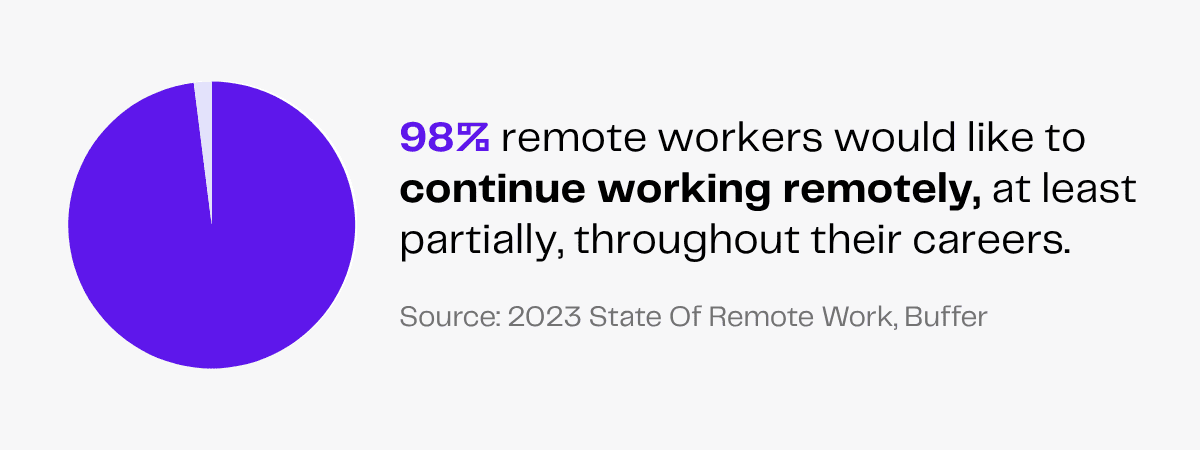
After experiencing the perks of remote work, employees don’t want to return to traditional office life. According to Buffer’s State of Remote Work 2023, 98% of remote workers would like to continue working remotely, at least partially, throughout their careers.
However, many businesses still prioritize face-to-face collaboration, a strong company culture and direct supervision.
I’m a firm believer in the importance of in-person collaboration. Yes, we have the ability to work remotely, but we also want to preserve our culture.
Cristiano Amon, CEO of Qualcomm
The reality is, if you don’t create as a community, it’s very difficult to maintain a strong culture.
To balance these employee expectations and organizational goals, companies started experimenting with different work models.
Here are the main types of remote workplaces.
Fully Remote Model
In a fully remote model, all employees work entirely remotely. The company may not even have a physical office.
It’s suitable for industries like software, marketing and customer support, where teams rely primarily on digital tools and no on-site equipment is needed.
Example: Buffer is a popular software company with a fully remote workforce spanning 22 countries and 11 time zones.
Hybrid Model
A hybrid model is where employees work both from home and the office.
This is implemented in various ways. Companies may ask employees to come to the office three days a week, but allow remote work for two.
Or, a business may have a fully remote social media team while other departments still operate on-site.
Let’s look at the different types of hybrid models.
Office-First
Office-first workplaces (also known as remote-friendly) expect employees to be primarily on-site, but offer the flexibility to work from home (WFH) on some days.
Teams may have a fixed quota of remote workdays or request them in specific cases such as illnesses, urgent personal matters or when there are no in-person meetings.
For office-first companies, face-to-face collaboration takes center stage and remote work is an additional perk.
Since workers commute to the office on most days, these companies generally hire talent who live nearby or are willing to relocate.
Example: Meta follows an office-first policy, requiring employees to be on-site at least three days a week.
Flexible Hybrid
Employees under flexible hybrid models can choose when to work from the office and when to be remote.
While this autonomy boosts motivation, work-life balance and overall job satisfaction, there are downsides too.
With no fixed remote days, some employees (like young men in junior roles) show up more often, while others (such as single working mothers) stay remote. This can lead to team disconnection and siloed workflows.
Managers may also be biased towards frequent office visitors. In a survey of global CEOs, 87% admitted they’ll reward on-site employees with better tasks, raises and promotions.
Example: HubSpot allows employees to choose between being full remote, mostly working from the office or combining both.
Remote-First
In this model, employees are encouraged to work remotely even though in-person work is an option.
Remote-first companies aim to optimize office space, reduce real estate costs and collaborate digitally.
Since everyone is remote by default, there’s no scope for unfair treatment due to proximity bias.
To strengthen interpersonal relationships, such companies often host occasional meetings and events at the office.
Example: Dropbox follows a virtual-first policy but ensures team-building by offering employees access to coworking spaces and connecting those in the same area through its Dropbox Neighborhoods Program.
Advantages of Remote Work
Millions of companies were fully remote during COVID-19. Although its prevalence dropped after the pandemic, remote work still makes up around 28% of paid workdays in the USA.
What explains the enduring popularity of remote workplaces?
For Companies
Remote work offers endless benefits to companies, from lower overhead costs and access to global professionals to increased productivity and happier employees.
Lower Expenses
Virtual teams reduce overhead costs like rent, equipment and utilities. Companies save about $11,000 per employee by switching to remote work!

By adopting a hybrid work model, businesses can hire more employees without needing to expand their office space.
Higher Productivity
Remote work boosts productivity. Contrary to expectations, employees are 62% more productive when working from home.
Hybrid workers report that working remotely helps them stay focused, think creatively and meet deadlines.
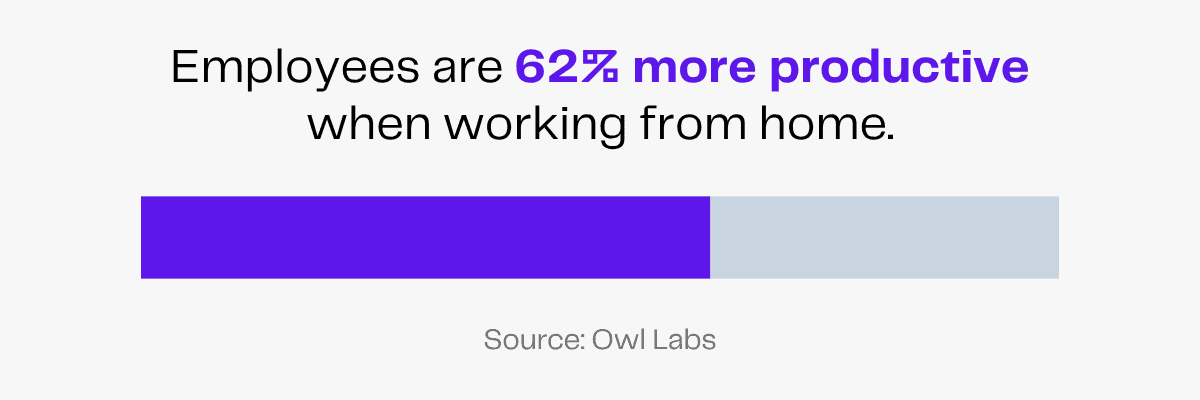
Increased Retention
Giving employees autonomy and flexibility boosts employee motivation, engagement and job satisfaction. This contributes to lower absenteeism and better retention rates.
Since the availability of remote work is attractive to job seekers, it’s easier to hire and retain employees.
Diverse Workforce
A rise in remote work has led to more diverse workplaces. Businesses can go beyond geographical boundaries and recruit the best candidates from a global talent pool.
This also attracts top talent since working in an inclusive workplace is important for 76% of employees.
What’s more, companies with ethnically and culturally diverse teams are 36% more profitable!

For Employees
Not so surprisingly, employees love remote work.
90% enjoy the flexibility and work-life balance it offers and 77% find it more productive than working in the office.
Flexibility
Remote work allows employees to choose a comfortable, distraction-free work environment.
They can log in from their homes, coffee shops, libraries, coworking spaces, hotels, airport lobbies or anywhere else in the world.
This also lets them access more job opportunities outside their place of residence.
More Personal Time
Skipping the daily commute gives employees more time for personal activities. Remote workers spend 60% of their time savings on indoor leisure, childcare, chores, home improvement and outdoor activities.
The flexibility of remote workplaces is also beneficial for people with different needs.
Working mothers can take breaks for childcare, doctor appointments or school pick-ups.
Similarly, people with mental health struggles, chronic illnesses or disabilities can complete tasks without physically traveling to their workplaces.
Work-Life Balance
Compared to in-person workers, remote employees are happier and more satisfied. They also experience less work-related stress and anxiety.

Plus, remote work allows employees to take better care of their health.
- 93% of workers say remote work boosts physical health.
- 92% say it improves mental health.
- 84% of workers eat healthier food when working from home.
Cons of Remote Work & How To Fix Them
As with everything, remote work has its own issues. Poor communication, technical disruptions and loneliness are a few of the common challenges remote workers face.
Communication Gaps
In remote workplaces, the absence of face-to-face interactions hampers communication.
Texts lack tone, body language and facial expressions, which often leads to misunderstandings if someone misinterprets a message.
If you have a global team, cultural differences and language barriers can also pile on and lead to miscommunication.
Tip to overcome: Set clear communication guidelines for tone, response times, message length, etc. Use chat for regular check-ins and routine updates, but switch to video calls for lengthy discussions.
Technical Troubles
Network issues and poor internet are inevitable for remote workers. They disrupt workflows, hinder collaboration and cause frustration.
Plus, unlike traditional office employees, remote workers don’t have instant access to an IT team. They’re responsible for resolving software issues on their own, which causes further delays if they aren’t tech-savvy.
Tip to overcome: Create detailed how-to guides for common technical errors and teach your employees to troubleshoot basic issues like clearing browser cache, updating software and restarting routers.
Loneliness & Isolation
In offices, colleagues chat during breaks, go for coffee together and celebrate events. These simple moments strengthen their bonds and make them feel more connected.
But such opportunities for socialization are completely missing in remote work. Interactions are strictly work-related, leaving employees feeling lonely and isolated.
Tip to overcome: To keep remote employees connected, make time for casual conversation, set up virtual coffee meets and host team-building activities.
Is Remote Work on the Rise?
The pandemic compelled most businesses to shift to remote work.
In 2019, only 8% of remote-capable employees worked fully from home. That number surged to 70% during the height of the pandemic!
Although some companies gradually returned to the office, many realized they couldn’t ignore the benefits of remote work.
Employees also started valuing flexibility and work-life balance above all, with 63% choosing a pay cut to stay remote.
At present, 26% of workers are fully remote, 55% follow a hybrid model and only 19% work exclusively on-site.
Findings by FlexJobs also reveal an 8% rise in remote job postings between April and June 2025. The most in-demand roles were in:
- IT & software
- Marketing
- Sales
- Customer support
Clearly, remote work is here to stay.
By adopting remote models, businesses can access global talent, lead a more productive workforce and boost retention.
Data also shows that remote roles attract more qualified candidates than location-based ones—a clear incentive for companies to prioritize remote hiring!
Top Roles To Hire Remote Employees For
About 37% of American jobs can be done from home. Sectors with the largest scope for remote work include:
- IT
- Education
- Legal
- Finance
- Management
- Media & entertainment
- Administrative support
- Architecture
- Social services
- Sales
On the other hand, jobs requiring specialized equipment or significant in-person interaction are not suited for remote work. These include positions in retail, agriculture, food preparation, construction and emergency services.
To get the most out of remote setups, hire for roles that thrive with strong communication, collaborative meetings and virtual team-building activities.
Below are the top remote roles to consider.
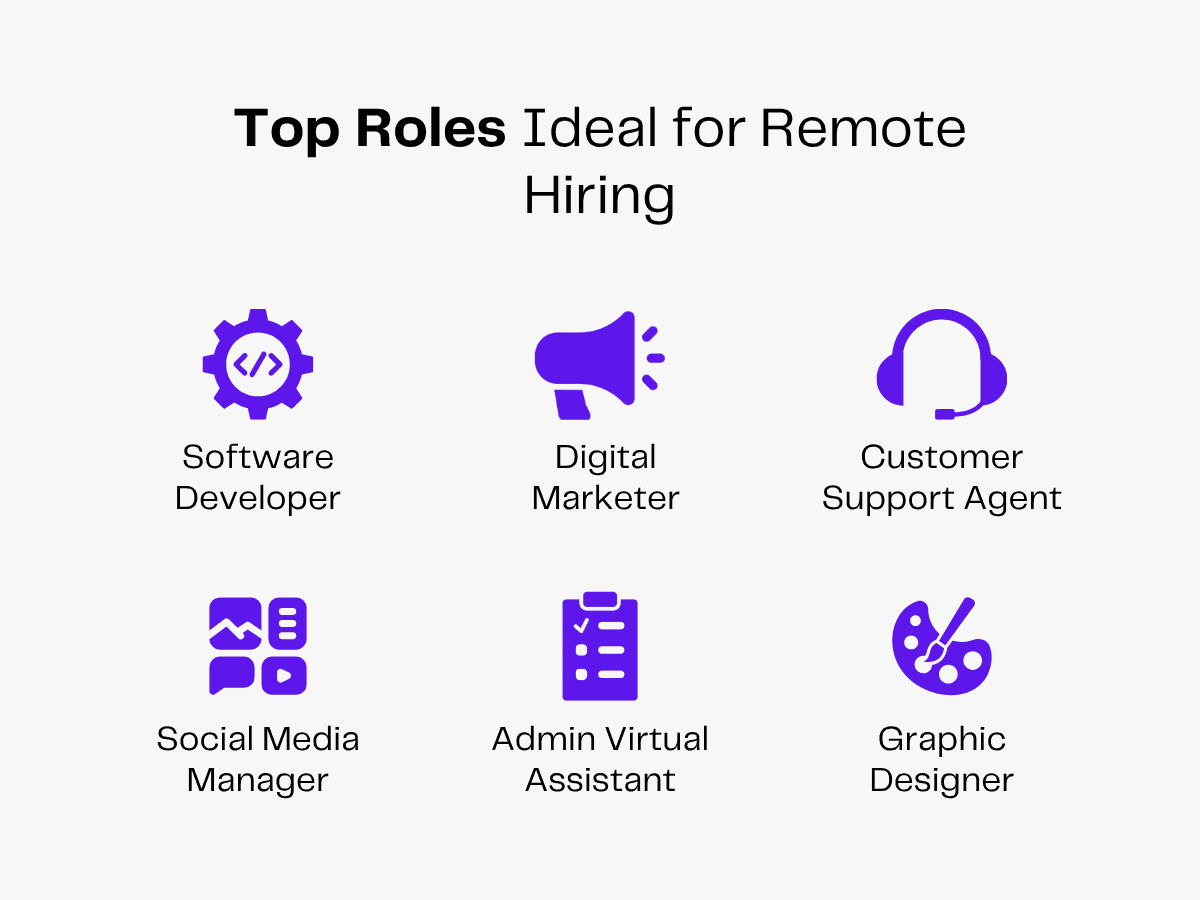
Software Developer
Remote software developers build mobile apps, web applications or custom software for your business. They handle everything, from design and coding to testing, deployment and maintenance.
Based on your needs, you can hire software developers specializing in various programming languages, databases and other technologies.
Digital Marketer
Remote digital marketers help you shine online by building a captivating online presence.
They create engaging content, post on social media, execute email campaigns and track performance to optimize your strategies.
Customer Support Agent
Customer service can make or break a business.
By hiring remote customer service agents, you can provide seamless support across phone, email, live chat and social media channels.
They answer queries, resolve issues quickly and communicate with empathy and professionalism, keeping your customers happy with personalized support.
Social Media Executive
A strong social media presence is non-negotiable in today’s age.
Social media assistants keep you visible and active on channels like Instagram, LinkedIn, X, Facebook and Pinterest.
They create engaging posts and interact with your audience, helping you gain more followers, likes and shares.
Admin Virtual Assistant
Tasks like data entry, recordkeeping, email management and appointment scheduling are essential to every business. However, they take up way too much time.
To save valuable hours, businesses can hire admin virtual assistants to handle such day-to-day tasks.
Graphic Designer
If you’re trying to stand out online, eye-catching visuals are a must.
A remote graphic designer can create brand logos, infographics, social media carousels and marketing materials to attract attention and elevate your brand image.
How Is Remote Work Changing in 2025?
The recent years have witnessed constant changes in the way we work.
From being fully remote during the pandemic to return-to-office (RTO) mandates, remote employees have been forced to adapt to countless new shifts.
So what’s next in the remote work landscape?
Hybrid Work Becomes the Norm
Recent surveys show employees are unwilling to give up the work-life balance and other advantages of remote work.
When Amazon’s CEO, Andy Jassy, posed an RTO mandate for 5 days a week, 91% of Amazon employees were unhappy with the decision.
73% said that they planned to quit and Amazon recruiters noticed several candidates dropping out of job interviews following the announcement.
Remote workers have also been openly vocal about their frustration with RTO policies, with one Reddit user saying,
There’s really zero reason to RTO. Our division is killing it WFH. There’s literally nothing we can do at the office that we are not doing now…
The verdict is clear: Employees are not happy in going back to the office.
As a solution to this problem, hybrid work models are becoming the norm. In the U.S., 88% of employers provide hybrid work options.
This gives both parties what they want. Employees get to enjoy flexibility, while managers can build a stronger team culture.
IT Firms Zero In on Borderless Hiring
Working remotely means colleagues don’t have to be in the same office. But now they don’t even have to be on the same continent!
In the tech industry, borderless recruitment is quickly becoming the future of work. This means hiring professionals from anywhere in the world.
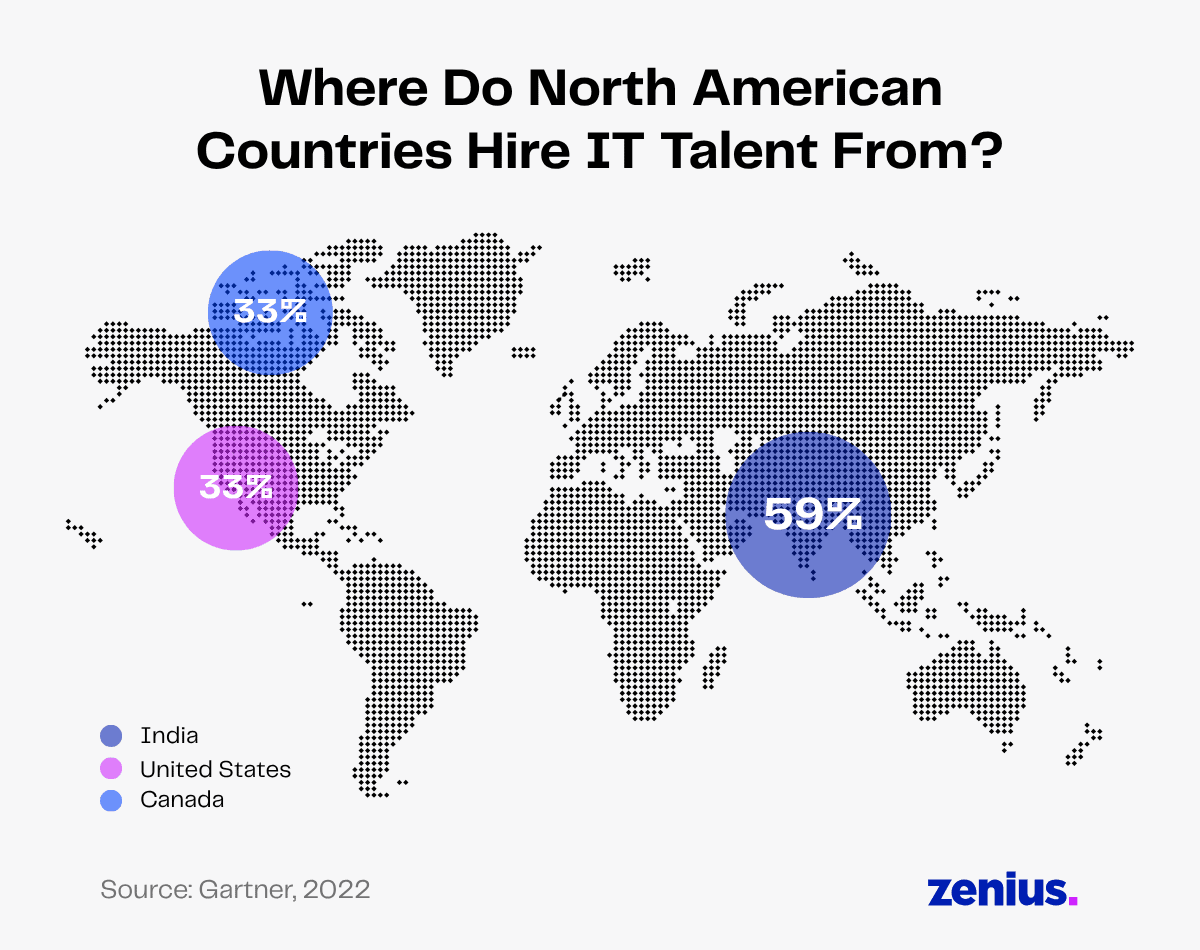
As per a Gartner report, borderless hiring has doubled in the last three years, with 27% of CEOs planning to onboard global talent.
Countries like India (59%), the USA (33%) and Canada (33%) are topping the list for supplying borderless tech candidates.
What’s the reason behind this shift? Companies cite these top benefits:
- Filling skill gaps (88%)
- Competitive edge (78%)
- Reduced operational costs (49%)
- Diverse cultural perspectives (40%)
IT support (58%), software development (56%) and data management (39%) are the most common roles CIOs are hiring for.
By no longer limiting themselves to local candidates, modern IT businesses are solely focusing on knowledge, skills and expertise. It’s all about who adds the most value, not just who’s nearby.
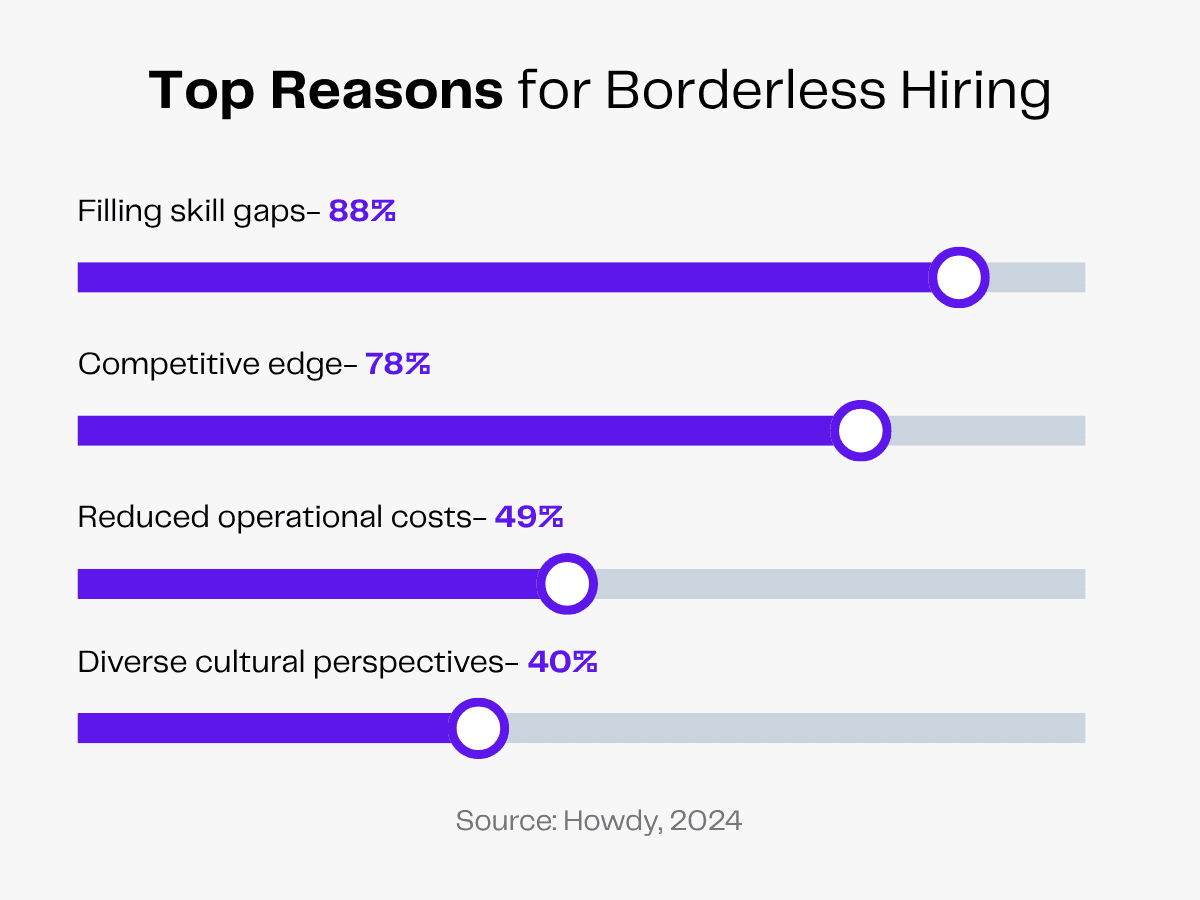
Wrapping Up
Remote work has become an integral part of modern life. Countless studies and statistics prove its impact on employee performance, well-being and job satisfaction.
Offering remote options also helps companies attract and retain the best talent.
However, many businesses still struggle to find reliable remote workers. The idea of sourcing, screening and interviewing candidates from the global talent pool seems daunting.
Plus, with so many horror stories of freelancers abandoning projects mid-way, doubts about reliability also creep in.
In such a scenario, outsourcing can be a viable alternative.
It allows businesses to embrace remote work without worrying about recruitment and management.
Instead of losing sleep over freelancer issues and missed deadlines, you can experience the real joys of having a remote team—diverse employees, no overhead and high productivity.